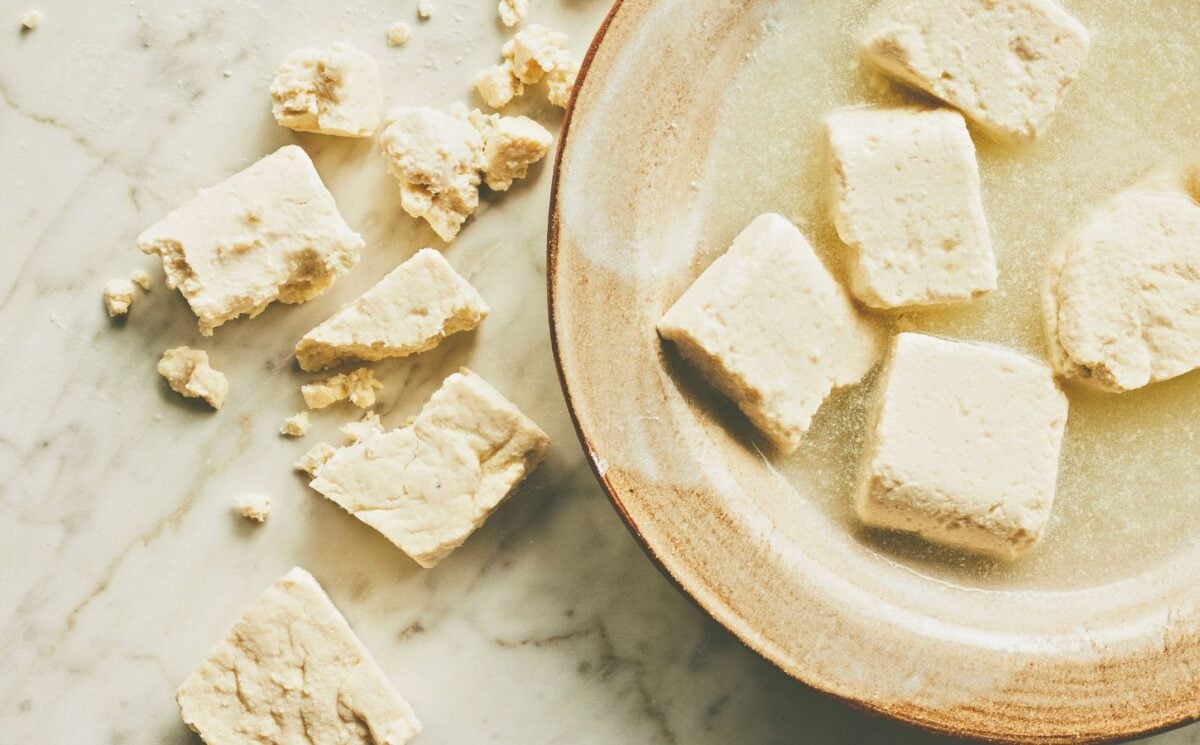Briny, tangy, and bursting with flavor, this plant-based feta is a game-changer. Creamy yet crumbly, it upgrades salads, pastries, and anything needing a savory hit.

Ingredients
- 3 cups (710ml) water
- 1 cup (140g) watermelon seed kernels
- ½ cup (70g) hemp hearts
- ½ cup (70g) almonds
- ½ cup (110g) refined or deodorized cocoa butter shea butter, or coconut oil, melted
- 1 teaspoon fine sea salt plus
- 1 tablespoon or more as needed for coating the cheese
- 1 teaspoon calcium sulfate
- ¼ teaspoon vegan thermophilic culture
For the brine
- Whey from draining
- 3 tablespoons sea salt
- 1 tablespoon distilled white vinegar if needed to lower pH
Instructions
- In a blender, combine the water, watermelon seed kernels, hemp hearts, almonds, melted cocoa butter, and 1 teaspoon sea salt and process until as smooth as possible, 1 to 2 minutes. Pour this mixture into a nut milk bag, squeezing to extract as much milk as possible into a medium saucepan.
- Set the saucepan over medium heat and bring to a simmer, scraping the coagulated curds from the sides and bottom slowly and frequently. When it has mostly curdled, stir in the calcium sulfate, which will help solidify the curds even more.
- Let this mixture cool until it is below 110°F. Stir in the culture. Put it in a sterilized container large enough to hold the cheese and then set it in a warm place where it will maintain a temperature between 95° and 105°F for 16 to 24 hours, until it reaches a pH of 4.6 or slightly below.
- Place a sieve or ricotta mold over a bowl or container and line it with a large piece of cheesecloth. Pour the curds into this to drain the whey into the container below (reserve the whey for the brine).
- Cover the top of the curds with the cheesecloth hanging down and place a heavy weight on it—a large, clean stone, heavy pot filled with water, or whatever you can find that will work—and allow the weight to press the cheese for 6 to 8 hours.
- When the cheese is firm enough to hold its shape, remove the cheesecloth and sprinkle it very generously on all sides with the 1 tablespoon salt. Put the whey in the refrigerator until later, and place the cheese back in the sieve over an empty bowl, or on a cooling rack (for baking), and let it dry at room temperature for a full 1 to 2 days until it is very firm; the salt will help to evaporate the moisture.
- Make the brine: After a couple of days, when the cheese is very dry and firm, take the whey out of the fridge. Measure it and add water to bring it to 2 cups. Heat the whey/water mixture with the salt and stir well to dissolve. Add the vinegar and allow it to cool (this can be made a day or two earlier as well).
- When the cheese is firm, cut it into large cubes or 1-inch slices and put it into a storage container big enough to fit it and all the brine. Store the cheese in the brine, making sure it is fully submerged in it, in the refrigerator, where it will keep for 6 to 8 weeks. It will get stronger in flavor and saltier over time. Alternatively, after brining the cheese for a week in the refrigerator, you can drain it and cover it in olive oil, where it will keep for 2 to 3 months. The cheese will be richer and not as salty or funky.
NOTE: If your feta is not as tangy as you like, add 1/4 to 1/2 teaspoon of citric acid to the brine. After a day or two, it should get tangier.